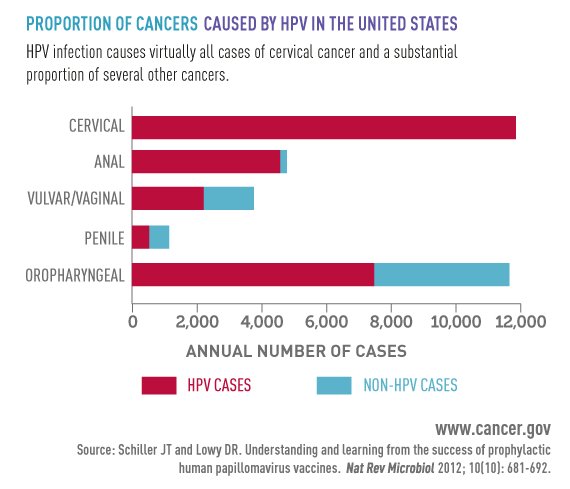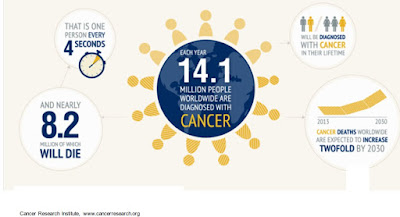UP TO DATE INFORMATION AND NEWS RELATED TO CANCER RESEARCH AND TREATMENT FOR CANCER PATIENTS AND COMMUNITY.
TRANSLATE
Friday, 1 December 2017
CANCER HELP ONLINE: Cancer treatment side effect: ChemobrainIn the l...
CANCER HELP ONLINE:
Cancer treatment side effect: Chemobrain
In the l...: Cancer treatment side effect: Chemobrain In the late 1990s, doctors began to pay attention to chemobrain, a term used by an increasin...
Cancer treatment side effect: Chemobrain
In the l...: Cancer treatment side effect: Chemobrain In the late 1990s, doctors began to pay attention to chemobrain, a term used by an increasin...
Link between viral infeccion and cancer: Prevention of cancer with anti-viral vaccines.
When you hear “virus,” you may think of minor, temporary illnesses, like the cold or 24-hour flu. But some viruses are also linked to certain kinds of cancer. As the medical community has learned more about these links, it has developed vaccines that, by protecting against certain viral infections, help prevent cancer. One of the most prominent examples is the human papillomavirus (HPV) vaccine, which was first developed a little more than a decade ago.When viruses cause an infection, they spread their DNA, affecting healthy cells’ genetic makeup and potentially causing them to turn into cancer. HPV infections, for instance, cause the virus’ DNA to combine with the host’s DNA, disrupting the normal function of cells. Other viruses, such as human immunodeficiency virus (HIV) and hepatitis C virus (HCV), may increase a person’s risk of developing cancer by affecting the body’s immune system. In most cases, specific viruses only affect specific cells in the body, such as common cold viruses that impact the lining of the nose and throat. That’s why certain viruses are only linked with certain kinds of cancer.
Although most people infected with HPV don’t develop cancer, a few potent strains of the virus cause the vast majority of cervical cancer, the second most common cancer in women worldwide. HPV causes about 98 percent of cervical cancer cases, so it is of high concern. HPV vaccines are highly effective in preventing infection with the types of HPV they target when given before initial exposure to the virus—which means before individuals begin to engage in sexual activity. Phase III clinical trials in young women found that HPV vaccines, Gardasil and Cervarix, can prevent infection with HPV types targeted by the vaccine and prevent the development of precancerous lesions The initial Gardasil study was so successful it was stopped early so that participants in the placebo group could also be offered the vaccine.
Other common types of viruses linked to cancer include:
- The Epstein-Barr virus (EBV), which is a type of herpes virus most commonly associated with causing infectious mononucleosis, or “mono.” EBV infections increase the risk of nasopharingeal cancer, some types of fast-growing lymphomas and some stomach cancer. Like HPV, EBV infections are common, but EBV-related cancer is not.
- Hepatitis B virus (HBV) and HCV, which cause viral hepatitis, a kind of liver infection. HBV- and HCV-induced chronic liver infections are rare, but when they occur, they raise the risk of liver cancer. Less than half of liver cancers in the United States are linked to HBV or HCV infection.
- HIV, which causes acquired immune deficiency syndrome (AIDS). HIV increases the risk for several types of cancer, including Kaposi sarcoma, cervical cancer, non-Hodgkin lymphoma, anal cancer and lung cancer.
Sunday, 26 November 2017
Cancer treatment side effect: Chemobrain
In the late
1990s, doctors began to pay attention to chemobrain, a term used by an
increasing number of patients to describe mental symptoms and side effects. Chemobrain,
can
also be called chemo fog, is a term used by patients to describe changes in their thinking, or
cognitive function. Depending on the person, “chemobrain” may refer to forgetfulness,
slower thinking, difficulty concentrating or periods of mental confusion or
“fogginess.” It’s difficult to pinpoint an exact definition, but it generally
describes a feeling that “my brain is not working quite the same as it was
before cancer.”
There are two distinct groups of cancer patients suffering from chemobrain.
In the first, patients with brain tumors can have changes in cognitive function
due to the location of their brain tumor and treatments that directly affect
brain tissue. However, chemobrain is often used to refer to cognitive changes
experienced by patients in the other group: those without cancer in the brain.
While the term chemobrain seems to directly blame the problem on chemotherapy,
it has been actually found that cognitive problems can appear before any
treatment begins. Even if cancer is not growing in the brain, it can still
disrupt systems in the body that end up affecting mental function. Some
treatment, including certain forms of chemotherapy, hormonal therapy and immunotherapy,
can also cause cognitive dysfunction, meaning they can directly or indirectly
disrupt, damage or alter normal brain function. Chemo brain seems to happen
more often with high doses of chemo, and is more likely if the brain is also
treated with radiation.
It's
not clear what causes signs and symptoms of memory problems in cancer
survivors. Cancer-related causes of chemobrain could include:
- A cancer diagnosis can be quite stressful in itself and this can cause memory problems
- Certain cancers can produce chemicals that affect memory
The chemobrain workout should rule out (or may reveal) other diagnoses,
such as dementia, anxiety, depression or fatigue, all of which can also affect
mental function.
For many patients, the symptoms of chemobrain improve over time, though
they may not go away completely. Some people may continue to experience
chemobrain symptoms long after they’ve completed their cancer treatment. Some cancer survivors may return to work, but find tasks
take extra concentration or time. Others will be unable to return to work.
Stimulants or brain training may help some patients. Cognitive strategies
or healthy lifestyle changes, like improved sleep quality and exercise, can
also help. Because symptoms and personal priorities vary from person to person,
the treatment plans needs to be personalized.
Still is a need to know more about cause or patients at risk for
chemobrain. Therefore, the scientific medical community has initiated the
clinical research in that field following cancer patients over several years to
understand it and bring better treatment or preventive options for survival cancer
patients in the future.
Thursday, 23 November 2017
Thursday, 16 November 2017
Subscribe to:
Comments (Atom)





